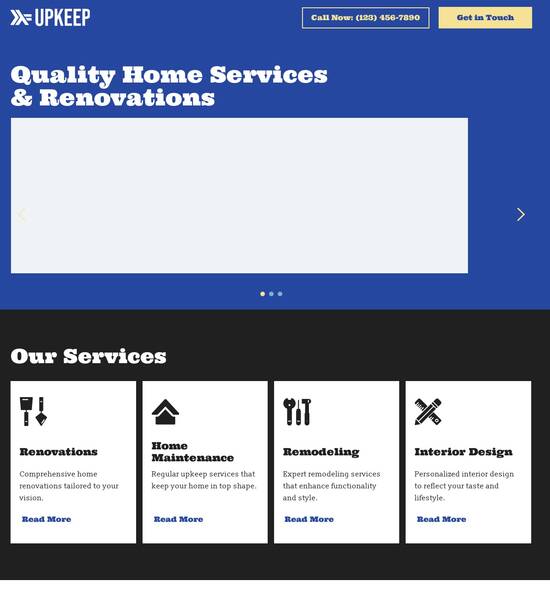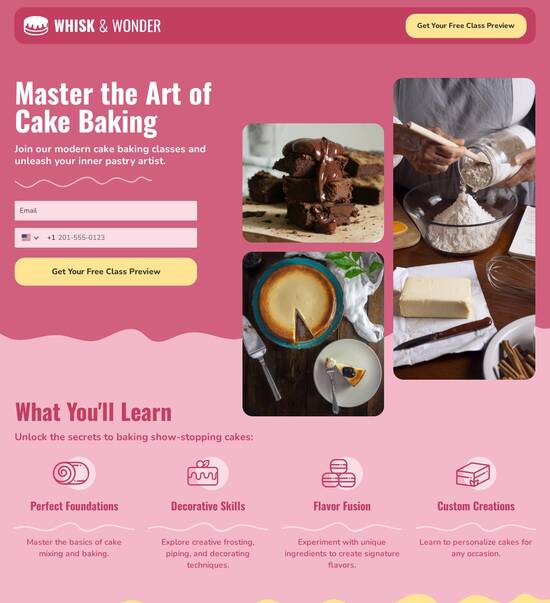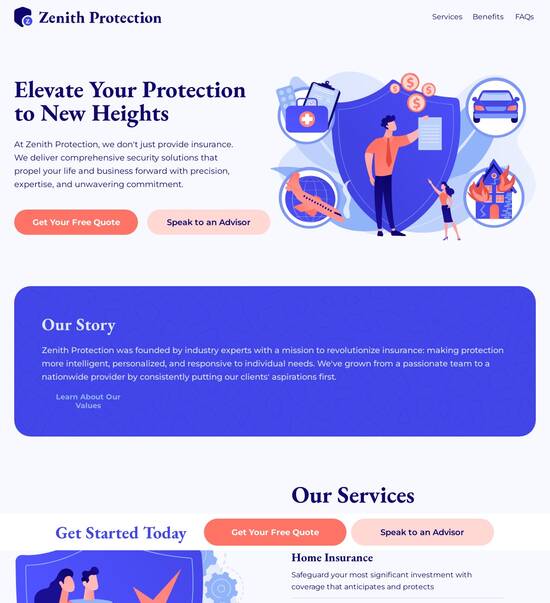
Product page template for Node.js developers
Explore Similar TemplatesAbout template
Master your online marketing with this builder for product page template for Node.js developers. Try more tools to create an immaculate landing page.
Recommended templates

Easy to build without coding
With the intuitive drag-and-drop builder, anyone on your team can create high-converting pages without any knowledge of code or design. Make enhancements to your landing page with custom widgets using Javascript, HTML/CSS, or third-party scripts.

Multiple layouts for any industry and goal
Select from 500+ landing page layouts built to boost conversions across industry-specific scenarios. Customize them by adjusting fonts, adding images, and generating on-brand content with the AI assistant. Quickly scale with Instablocks® and Global Blocks that you can save, reuse, and update globally.

Loads fast and looks polished on any device
Every template is responsive, which means they present professionally on any device and load blazingly fast with our Thor Render Engine. You can also power them up with Google AMP technology to deliver an unparalleled mobile experience and drive higher conversions.

Robust analytics & experimentation
Get real-time updates and reporting across all your devices, showing the number of visitors, conversions, cost-per-visitor, and cost-per-lead. Launch AI-powered experiments, run A/B tests, and use heatmaps to analyze user behavior, then optimize your landing page to maximize conversions.







Easy to build without coding
With the intuitive drag-and-drop builder, anyone on your team can create high-converting pages without any knowledge of code or design. Make enhancements to your landing page with custom widgets using Javascript, HTML/CSS, or third-party scripts.
Multiple layouts for any industry and goal
Select from 500+ landing page layouts built to boost conversions across industry-specific scenarios. Customize them by adjusting fonts, adding images, and generating on-brand content with the AI assistant. Quickly scale with Instablocks® and Global Blocks that you can save, reuse, and update globally.
Loads fast and looks polished on any device
Every template is responsive, which means they present professionally on any device and load blazingly fast with our Thor Render Engine.
Robust analytics & experimentation
Get real-time updates and reporting across all your devices, showing the number of visitors, conversions, cost-per-visitor, and cost-per-lead. Launch AI-powered experiments, run A/B tests, and use heatmaps to analyze user behavior, then optimize your landing page to maximize conversions.
All the features you need to build lead-generating landing pages
Explore more featuresLearn how to build top-performing landing pages for any goal
FAQs
Leading the way in building high-performing landing pages





A comprehensive guide to using Instapage for powerful landing page creation
Creating effective landing pages is essential for maximizing conversions in your digital marketing campaigns, especially for marketers working in various sectors like tech, education, financial services, and more. Instapage's robust platform offers marketers the tools they need to accelerate their campaigns and maximize ROI without requiring advanced coding skills.
Understanding the value of landing pages
Landing pages are critical in guiding users toward a specific action, whether it be making a purchase, signing up for a newsletter, or engaging with your content. With Instapage, marketers can access a library of over 100 high-converting templates that can be customized according to their unique needs. The platform allows rapid creation and optimization of landing pages that can significantly boost conversion rates.
- High-converting templates: Instapage provides access to a wide variety of professionally designed templates that cater to different industries and campaign goals.
- Built-in optimization features: Analyze landing page performance with detailed heatmaps and A/B testing to make data-driven decisions.
- User-friendly builder: Create visually appealing landing pages without the need for extensive development skills, streamlining the page production process.
Step 1: Launching your first landing page
To get started with Instapage, follow these simple steps to launch your first landing page:
- Choose a template: Select a pre-designed template that aligns with your marketing goals.
- Customize content: Utilize Instablocks to personalize your content and ensure it resonates with your target audience.
- Add lead generation elements: Incorporate forms and CTAs to encourage user interaction and data collection.
Step 2: Optimize for performance
Optimizing your landing pages is key to improving your conversion rates. Here’s how to enhance your pages effectively:
- Utilize heatmaps: Monitor user behavior on your page to identify where visitors engage most and adjust your layout accordingly.
- Conduct A/B testing: Test variations of your landing page to find out which elements perform better and lead to higher conversions.
- Leverage analytics: Use Instapage's integrated analytics dashboard to track metrics like traffic sources, conversion rates, and user retention.
Step 3: Personalize the user experience
Personalizing your landing pages can significantly impact your conversion rates. Consider these strategies:
- Dynamic text replacement: Tailor your messaging based on user behavior or campaign-specific keywords to increase relevance.
- AdMaps: Align your ads with specific landing pages to create a seamless transition for users.
- Audience-level tracking: Monitor how distinct segments of your audience interact with your landing pages to refine your approach.
Incorporating these strategies will enhance your campaigns, ensuring you reach your audience effectively and efficiently.
Are you ready to supercharge your landing pages and optimize your campaigns with Instapage? Sign up today to discover the powerful tools that can elevate your digital marketing efforts.
Product page template for node.js developers
Understanding the need for a product page template in Node.js development
Product page templates play a critical role in enhancing user experience and increasing conversion rates for any online platform. They provide a structured approach to presenting product information, making it easier for users to find relevant details and make purchasing decisions. For Node.js developers, creating these templates efficiently can significantly impact the overall performance of an application, as well as its scalability over time.
Node.js developers face unique challenges when it comes to building product pages due to its asynchronous nature and the complexity of server-side rendering. Unlike traditional web development frameworks, Node.js requires a different mindset for data handling and rendering components. Thus, developers may encounter difficulties in ensuring fast load times and effective state management, especially when dealing with dynamic content that necessitates real-time updates.
By leveraging streamlined solutions like customizable product page templates, developers can minimize time spent on repetitive tasks while enhancing maintainability. These templates allow for rapid iterations and adjustments based on user feedback without compromising performance.
Tailoring product page templates: features to consider
When developing product page templates, there are several key features to consider to ensure adaptability and optimal performance. Focusing on these elements can significantly enhance both user experience and development efficiency.
Customization capabilities: Customizable templates allow developers to tailor pages to meet the diverse needs of users. By making content dynamic and responsive to user interactions, these templates can improve engagement and satisfaction.
Responsive design: A responsive design is crucial to delivering a seamless experience across devices. Utilizing frameworks such as Bootstrap or Tailwind CSS can facilitate the creation of adaptable layouts within Node.js.
Performance optimization: Ensuring quick load times and responsiveness requires strategic use of caching, image optimization, and code splitting. Tools like PM2 and New Relic can assist Node.js developers in monitoring and optimizing application performance.
Scalable solutions: As your application grows, product page templates should support scalability. Node.js excels in handling numerous simultaneous connections, making it well-suited for applications with fluctuating traffic patterns.
Essential technological stack for Node.js product page development
Choosing the right technological stack is vital for Node.js developers when building product pages. Two popular stacks that can significantly enhance the development process are the MER(N) and MEVN stacks.
MER(N) Stack: This stack includes MongoDB, Express.js, React.js, and Node.js. It allows for building dynamic single-page applications (SPAs) that provide a smooth user experience, leveraging React's powerful UI capabilities.
MEVN Stack: Comprised of MongoDB, Express.js, Vue.js, and Node.js, the MEVN stack is known for its versatility and ease of integration. This stack is particularly favored for projects requiring rapid prototyping and frequent updates.
Understanding which stack best serves specific project needs can lead to improved productivity and a more effective product page development process.
Key functional components of a product page template
A product page template should be designed with several functional components in mind to enhance usability and ensure a comprehensive presentation of information. Each element plays a unique role in facilitating user engagement and supporting business objectives.
User management: Establishing user roles and permissions is essential for managing product pages. Integrating authentication services like OAuth or JWT allows for secure access control.
Product information display: It's important to adhere to best practices when presenting product details. Consider incorporating image galleries, video embeds, and interactive elements to engage users effectively.
Reviews and ratings section: User-generated content, such as reviews, enhances credibility. Integrating a review system provides valuable insights and helps potential buyers make informed decisions.
Shopping cart integration: For smooth cart management, employing API approaches facilitates maintaining state and processing transactions efficiently within Node.js.
Dynamic pricing models: Templates should accommodate various pricing strategies, such as discounts and subscriptions, while supporting real-time updates and stock management.
User experience optimization: best practices for product page templates
Optimizing user experience on product pages is crucial for driving conversions. Focusing on design principles that prioritize navigability will lead to a more satisfying experience for all site visitors.
Implementing A/B testing on different configurations of a product page template can help identify which versions perform better in terms of conversion rates. Additionally, considering accessibility ensures inclusivity for users with different needs. Adhering to WCAG guidelines can provide a more equitable user experience that expands your audience base.
Administrative functionality: empowering backend developers
An effective product page template should also incorporate administrative functionalities that empower backend developers. Features like inventory control, sales analytics, and user engagement metrics contribute to a well-rounded approach to product management.
Robust backend APIs facilitate communication between the frontend and backend components, ensuring smooth data flow and enhancing overall application performance. Incorporating dashboards for real-time monitoring and management provides necessary insights for decision-making.
Real-world applications and case studies
Exploring real-world applications of Node.js product page templates can provide valuable insights and inspiration for developers. Various case studies showcase successful implementations, highlighting how tailored templates have improved user experience and business performance.
User testimonials often illustrate the tangible benefits derived from implementing these templates, from increased conversions to improved user satisfaction, making a compelling case for investing in well-designed product pages.
Future trends in product page development with Node.js
As technology continues to evolve, so too does the landscape of product page development. Emerging technologies such as artificial intelligence and machine learning hold significant potential for enhancing product page functionality. These innovations can enable dynamic content personalization and predictive analytics, offering a tailored user experience.
Additionally, user management systems are evolving to support more nuanced approaches. As developers, understanding these trends helps anticipate future challenges and opportunities in template design and customization within Node.js frameworks.
Conclusion: crafting the ultimate product page experience
In summary, the key takeaways for Node.js developers when designing product page templates emphasize the need for adaptability, user-focused design, and leveraging advanced technology stacks. By crafting these templates with a keen understanding of user needs and project goals, developers can create impactful product pages that drive conversions and foster user engagement.
Encouraging innovative thinking and exploration of new solutions will enable developers to stay ahead of emerging trends, ensuring their product pages provide the best possible experience for users.
Ready to skyrocket conversions?
Supercharge your ad campaigns with high-performing landing pages
Get started














